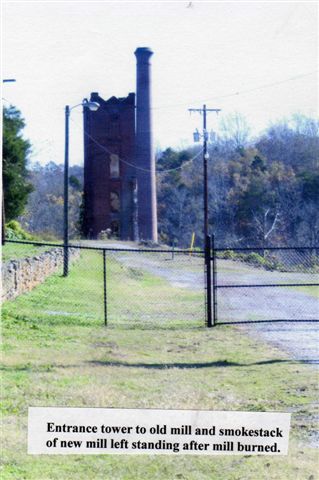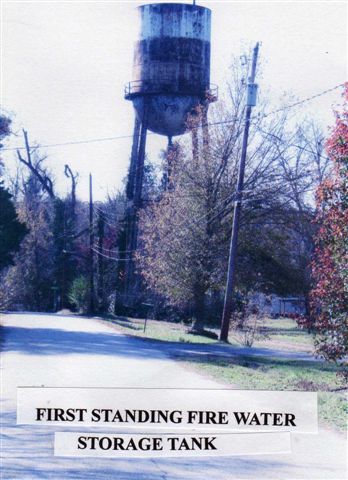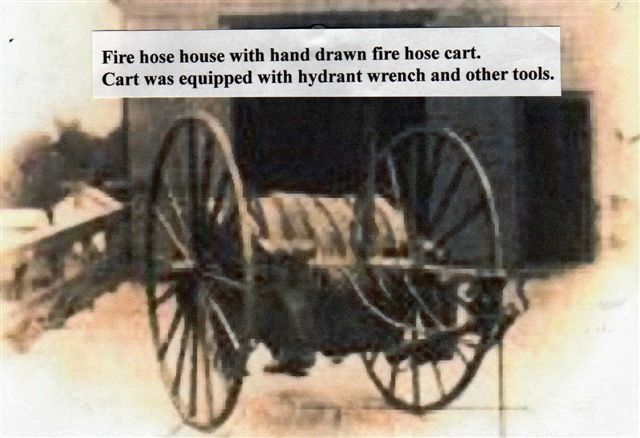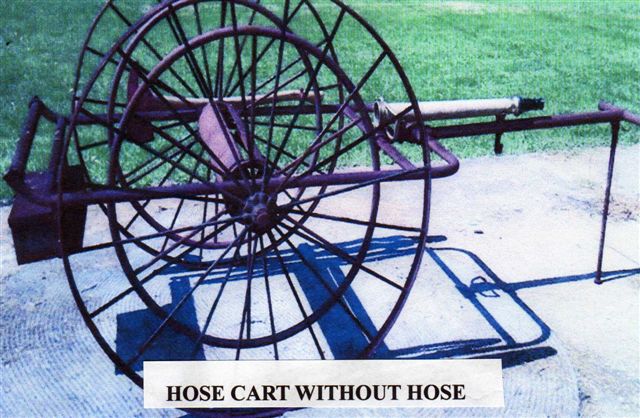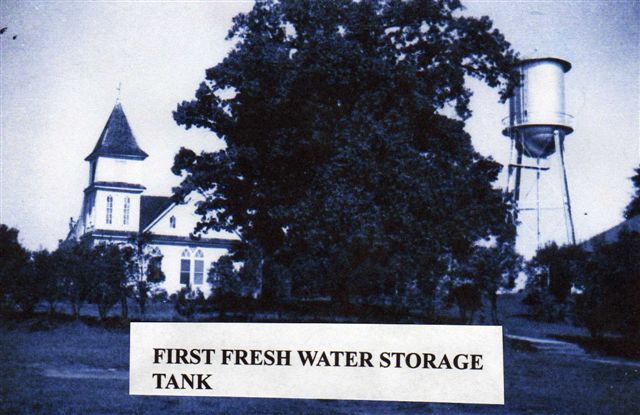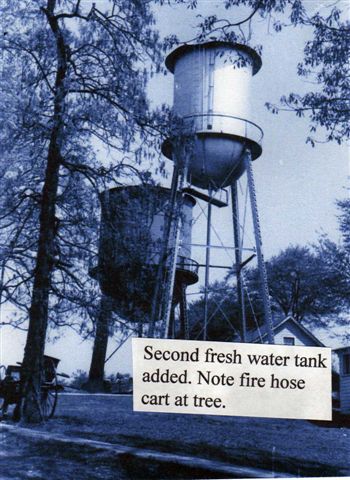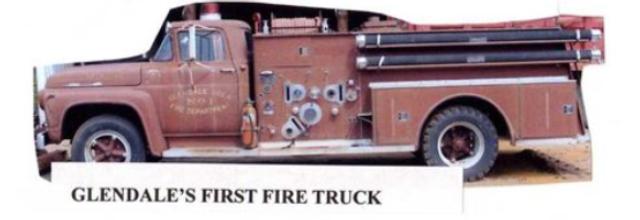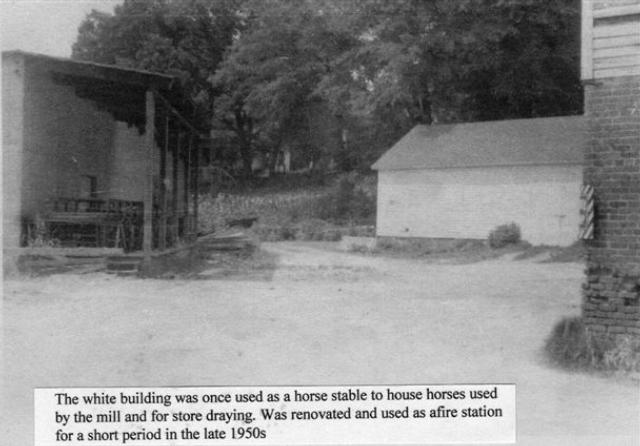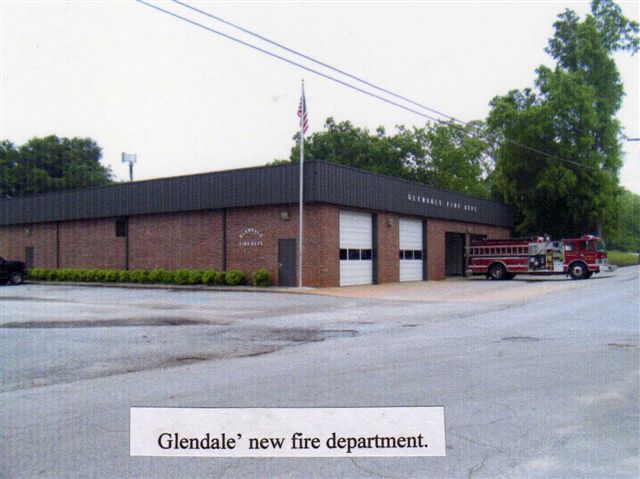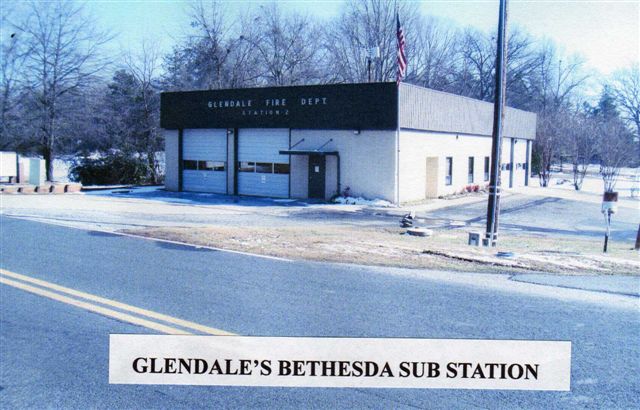Glendale's Fire Protection
1890-2010
Story furnished by Clarence Crocker
To my knowledge, the first fire protection Glendale Mills had was limited to a large open top, square steel plate water tank which was located in the very top of old #2 mill entrance tower which was built in 1890. It was fabricated on site and was kept filled with river water which flowed by gravity down into pipes in the mill where fire hose were mounted on the walls to be used in case of fires. When I looked at the tank back in the late 1940s, having not been in use for years, it had about a foot of water with four to six inches of mud covering the bottom of the tank. As best I remember, we had it cut out in the early fifties. Though it was long before my day with the Mill Company, I was told by various old timer mill workers that in the early days, it also supplied water to gutters along the top of the old #2 mill weave room windows which dripped water in front of the opened widows, adding humidity to the weave room years before the automatic humidifying system was installed. Though the mill burned in 2004, the tower still stands.
In 1902 the new mill addition had been built and a large fire water storage tank (which stands today) was erected on what was first named Main Street (Douglas Street today) behind the “Biving’s” house. It was erected by the Chicago Bridge and Iron Works of Chicago, Ill. Pumps kept the tank filled with river water. It supplied water for a closed “wet/dry-pipe” sprinkler system which was installed in the mill, the cloth warehouse, the cotton warehouse and the Mill Store.
In locations subject to freezing, the pipes were kept filled with air under pressure which kept the water check valve clapper closed. When a sprinkler head was melted by the heat of a fire, the air was released thus opening the clapper valve to flood the burning area with water. Pumps were located in front of the mill plant, on the side of the store and at the back of the cotton warehouse to control water and air pressure. Too bad that the system wasn’t active on March 21, 2004 when the mill building caught fire and burned.
Small fires in the mill were quite common, especially in the opening and card rooms where bales of cotton were opened, cleaned and combed. Small rocks from the cotton fields or metal particles from the ginning process were oft times in the cotton and would spark fires when coming into contact with the machines.
On one occasion, after I had taken Supervision of the engineering department, J. B. Lanford who was Mill Superintendent at the time, called me about 1 in the morning saying that a major fire had broken out in the card room and most of the aprons were burned. He said, “we have only enough cotton processed to keep the mill running for about five or six hours, we desperately need aprons .” I told him to call the supplier in Gastonia, N. C., telling him we would be there in about an hour to pick up the needed aprons.
I had just purchased a new 55 Ford Mercury with a large trunk which had a kilometer rather than a speedometer. Picking J. B. up at his office, we took off to Gastonia. When I got on the interstate, I set the car on about 95 which meant I was doing about 75. I had not explained the difference to J. B. After traveling for a while, I asked J. B. where we should turn off. He said, “back about a quarter mile”. I asked, “why didn’t you tell me”. “Man“, he said, “at 95 I couldn’t hardly get my breath, much less talking”. We picked up the needed aprons and on the way back I told him about the difference in the speedometer and we laughed about that incident all the way back home and for a long time after.
Glendale village fire protection in the early 1900s was limited to the stationary fire water pump, the river water storage tank previously mentioned , four and six inch cast iron water lines up the village streets, a few scattered fire hydrants and a few small ten by ten hose houses, strategically located throughout the village. A two wheel hand drawn hose cart holding several hundred feet of fire hose, a hose wrench and a fire hydrant wrench was stored in each hose house. Shop personnel formed the fire brigade and manned the carts in case of fires.
The first two fresh water wells of which I have any record or knowledge of, were located adjacent to the Bivingsville Cotton Mill and among the first houses that were built in the village. The well adjacent to the mill, by electric pump, supplied fresh water for drinking and rest room facilities in the mill. Incidentally, when Glendale plant #2 was built in 1890, it was built over this well and it was still supplying water in the 1950s. The second well was located on Main Street directly behind Dr. Biving’s house. A hand pump was installed in that one well. As the village grew, wells from which water was drawn by bucket, were located at central locations on most every street. It was not until 1917 that fresh water was piped into each village house and toilet facilities were added.
In an article presented in the Tenth Annual report of the Commissioner of Agriculture, Commerce and Industries in 1918, (I have a copy) Mr. Wilton Lindsay, President of D. E. Converse Co. (Glendale Mills Division) at that time, reported that “in the past year we have installed septic tank closets in our mill village and contracted for electric lights and a movie projector was purchased for the Community building.” A flat, box like sink was also installed.
In order to run fresh water to the homes, the trunk lines which had supplied river water to the village fire hydrants for fire protection for some 15 years, were converted to fresh water lines. This required that a valve located under the cloth warehouse which controlled the river water to the hydrants, be cut off and the lines purged. After that date, all fires in the village were fought with fresh water from mill company wells. Though the river water valve had been closed for many years, it remained in the line when I left the mill. A fresh water storage tank was erected at the side of the Glendale Baptist Church.
A new fire water pumping and pressure control station providing protection for the mills, store and warehouses, was built between Plant #3 and the cloth warehouse in the late 1940s. John T. Varner Jr. was shop foreman at the time and was placed in charge of maintaining these systems. Big pressure gauges showed if the lines were charged properly. The fire insurance inspector came from time to time, unexpectedly, to see that all specifications were being met.
On one occasion, at the inspector’s request, John started the pumps and when the pressure got to the maximum point at which it was to be operated, John cut the pump back. The inspector asked if that was as high as it would go? “Of course not” John replied, “but if I take it higher, pipes will pop.”. George Hodge, who was the mill Engineer at that time, told John to “bring it on up.”“O.K“. John replied, “but look for some pipes to burst”. Speeding the pump up, suddenly all pressure was lost. Hearing a noise and looking out the window, they saw the fire hydrant behind the mill office had popped out of the ground with water gushing everywhere. That was the last time anyone asked John to bring pressure up above what he knew was to be the maximum.
By 1954, with all homes in the village having been remodeled, additional toilet facilities and a sewage treatment system installed, additional fresh water wells having been purchased, a new 60,000 gallon fresh water tank was added supplying the village with sufficient storage of fresh water for drinking, bathing, sewer and fire protection which was still limited to the company fire brigade and hose carts.
After the houses had been sold, knowing that the company would no longer provide fire protection, Mr. deLoach, Executive Vice President and General Manager of Glendale Mills, felt that a volunteer fire department needed to be organized. Being Supervisor of the engineering department, Mr. deLoach asked me (Clarence Crocker) to work up some figures for his information on the cost of such, including the insurance savings home owners would save by having a fire department.
Checking with insurance carriers, I found that the insurance savings per year in most all cases would be greater than the estimated membership cost per year. After discussing the material which I had gathered with Mr. deLoach, he suggested that the fire truck could be housed in the old company garage, saving the cost of a new building. Since this was to be a homeowners project, Mr. deLoach discussed this matter with Jack Key and Ernest Alley. After giving them the assurance of the companies support, they took up the suggestion and began canvassing the village home owners concerning the fire protection plans.
In 1958 a Public meeting was held in which they were successful in organizing the Glendale Area Fire Protection Association, Inc. with a roster of 29 volunteer fireman. Ten Directors were elected. W. T. Rothrock Jr., Chairman; Howard Lee, Treasurer; E. F. Alley, Vice Chairman; E. C. Hopper, Secretary; Clarence E. Crocker, E. C. Brown, W. A. Jones, Howard Millwood, W. T. Rothrock, Sr. Jack Key was elected as the first Fire Chief and Ernest Alley was elected as assistant Fire Chief. Membership fees were set at ten dollars per year per household. Plans for the purchase of the first fire truck by a loan through the First National Bank was made.
The first fire truck, an American LaFrance, was purchased at a cost of approximately $14,000. Having no fire station, the truck was stored in the old mill company barn where the dray mules and dray wagons were once housed. It had been renovated for the mill store and mill trucks. The barn was located between the old Community building and the old tin cotton warehouse.
The fire department volunteers took an active role in community affairs. In 1960 they collected and prepared toys to give to Glendale Children. See the photo at Christmas -1960.
Today, Glendale fire Department has a large fire station located on Church Street on the old school grounds, in the heart of the village. It was built in 1964 at a cost of approximately $500,000. It also has a well equipped satellite station at the intersection of Brown and Bethesda roads which was built in 1994 at a cost of approximately $ 220,000. Today the department has 9 trucks; 3 pumper trucks, 1 ladder truck, 1 rescue truck, 2-1700 gallon tankers, 1- 4400 gallon tanker, 1 brush truck and other equipment at a total cost of approximately $ 1,545,000.
At the beginning, all fireman were volunteers. Today they have 6 full time paid fireman and 17 volunteers. Robert Brown, Sr. was elected Fire Chief in 1976 and remains such as of this writing. (August 2010) Robert Brown Jr. is assistant Chief. Present fire Directors are; Edward E. Brown, Jeff McKinnish, Terry Gilmer, Glenn Hammett and William (Billy) Gossett.
Personally, and I believe their record proves me out, Glendale has a Fire department second to none. They are professional and efficient. During the few times I have been able to observe them in action, I was impressed by their sincere concern and responsibility. My hat’s off to our Fire Department. Glendale community is indeed fortunate to have such a fine fire department.
Today, the village of Glendale and most of the immediate surrounding area, is furnished water and sewer services by the Spartanburg Water Works of Spartanburg, S.C. Both fresh water tanks have been removed. Only the old river water storage tank located on Douglas Street used for fire protection in 1902, stands idle by the side of the road collecting rust, bird nests and wild vines. I did notice what appears to be a radio antenna mounted at the top when I last passed by. In bygone years, when they caught Mr. Quinn, the village Policeman looking the other way, adventurous boys would dare climb the tank and write or draw on the side.
When I went down to take a picture of the tank back in early 2010, I stood there and began to reminiscence. I became very sentimental. Looking down the street, I saw the burned skeleton towers and smoke stacks standing like a tall statue, as a monument to a once vibrant mill, the bread basket for hundreds of workers and their families for almost 150 years. The once beautiful home of the Twichells, was slowly but surely decaying. The stately mansion of Dr. Bivings, founder and builder of the mill and village, which at one time would have been a “must see” showplace in any town, stood in disrepair.
Looking up the street, I saw the houses where some of the finest people that could be found anywhere, once lived. Sadly, there were no more Alleys, Cash, Warrens, Murrays, Hammetts, Nichols, Burgess, Gregorys, Mittags. The old generation was all gone. I am so proud to have known them and call them, “friends“. The street seems empty without them but precious memories makes standing there worth while. The Methodist Church which had it’s beginning as the Community Church with the founding of the village some 175 years ago, was closed. Its impact on the community can never be measured. Some of the first schooling the children of Glendale had in the early 1800’s, was in the Community Church. Main and Mill Street signs have long since been taken down and for the most part, forgotten. Incidentally, I know of no native son or daughter of Glendale living in the village today who is as old as this writer, 85years, nine months. (wow! -1029 months) I have had a good and blessed life for which I am truly grateful to God.
On a second visit to the water tank, I was reminded how that time and life moves on. The charred remains of the burned mill have been cleaned up, grass planted, the area landscaped. The property has been donated to Wofford College. They have had the Mill office renovated and is now occupied by College classes.
Glendale Avenue and Douglas Street have taken the place of Main and Mill. The Bivings Mansion was being restored. The houses on the street have been painted, many remodeled and new families have moved in. Though it doesn’t look the same, the sight is pleasant and hope runs high. Yes, life moves on and so must I if I am to finish the nuggets of Glendale history which I hope to write and post before I too, pass on.
My sincere appreciation to Chief Robert Brown for supplying me with figures and names regarding the Glendale Fire Department.

This web site has been started as a public service to share the story of Glendale. See more information about Mary and her Glendale connection at Mary McKinney Teaster.
